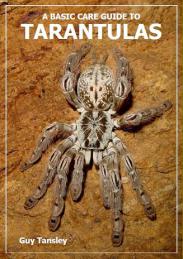
The genus Poecilotheria Simon, 1885 contains some of the most
strikingly coloured tarantulas available within the hobby. All are large arboreal spiders that are covered with variegated stripes and spots of black and white. Most species have bright yellow
warning colours on the underside of the first pair of legs and although not overly aggressive, they should never be handled. They breed well in captivity and captive bred specimens of most species
should be available. Breeding can be straight forward, the male can sometimes be left with the female for several days as their courtship can continue over many nights. On average around 150 young
are produced. Although not recommended for beginners, Poecilotheria spp. Are a must in any serious collection. Some species have shown some degree of social behaviour both in the wild and captivity and if a large
enough container is used with multiple hiding places, communal set-ups can be achieved. All individuals should be from the same egg sac, however, and introduced at the same time. Males should be
removed as they mature to avoid inbreeding and a plentiful supply of food made available at all times. A highly arboreal genus that constructs it's webs in dead tree stumps and broken off branches
etc. Common names include Indian ornamental, Sri-Lankan ornamental etc, tiger spiders etc. and the largest species can reach up t0 16 cms in legspan. Most will thrive in average temperatures (75oF)
but some from higher altitudes prefer lowers temperatures (see individual descriptions) A. typical arboreal set-up is recommended. Taller container with a slab of cork bark / bamboo tube against one
side behind which the spider can build its retreat. Thin layer of moist compost substrate. These spiders abhor bright light so keep this in mind when setting up the environment. More on housing can be found here.
Common species in captivity:
P. fasciata - (Latreille, 1804) Sri
Lanka
Similar to P. regalis (see below) but with slightly different markings.
P. formosa - Pocock, 1899 India
Similar to P. regalis (see below) but smaller and more colourful in size. Some specimens show striking purple on the carapace.
P. metallica - Pocock, 1899 India
Some say P. metallica is the most beautiful species of tarantula ever seen. Coloured with shades of vivid blue and yellow. Captive breedings are rare and for this reason it is also one of the highest
priced species available.
P. miranda - Pocock, 1900 India
Another rare species in the genus with similar markings to P. regalis but with an overall more white colouration. Some specimens also have red hairs on the abdomen and some purple to the legs.
P. ornata - Pocock, 1899 Sri Lanka
Overall colouration is brown but with some yellow so more subdued in appearance but stunning nevertheless.
P. regalis - Pocock, 1899 India
The most popular and easy to obtain species in the group. Captive breeding is relatively straight forward so spiderlings are usually available at a reasonable cost. Fast growing and voracious
feeders, females can mature in 18 months and on average, they live for around 10 - 15 years. Hardy in captivity and if housed accordingly, they make good display animals.
P. rufilata - Pocock, 1899 India
The largest of the genus reaching up to 16 cm legspan and an overall green and orange colouration.
P. smithi - Kirk, 1996 Sri Lanka
Similar to P. regalis but very rare in collections.
P. striata - Pocock, 1895 India
Similar to P. regalis and still rare in the hobby.
P. subfusca - Pocock, 1895 Sri
Lanka
Another beautiful species that benefits from lower temperatures. A highland mountain species that due to it's captive requirements is proving difficult to breed in captivity. A very dark species in
colouration compared to others in the genus.
P. vittata - Pocock, 1895 Sri Lanka
Formerly known as P. pederseni. Similar to P. regalis but with darker abdominal patterns.

